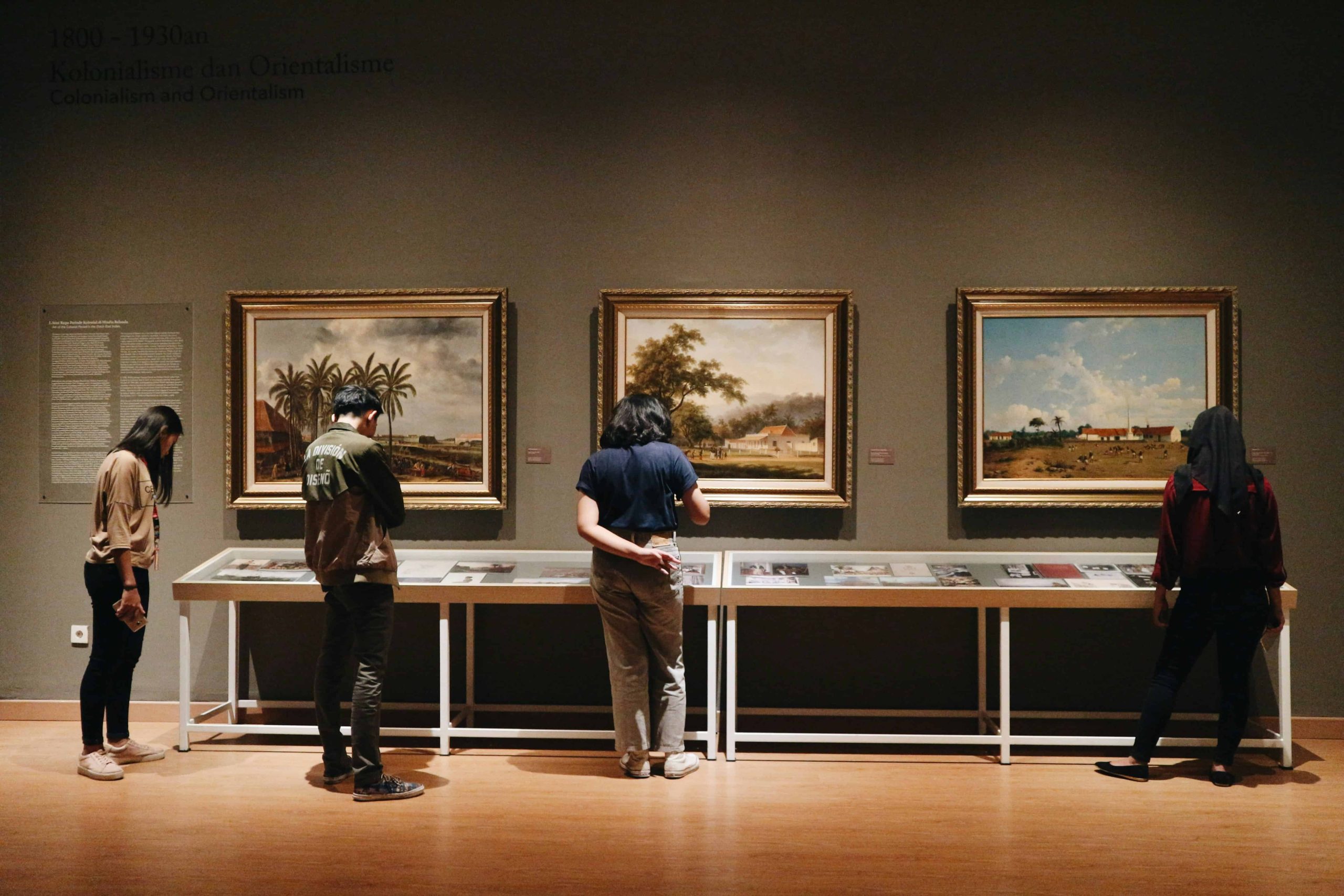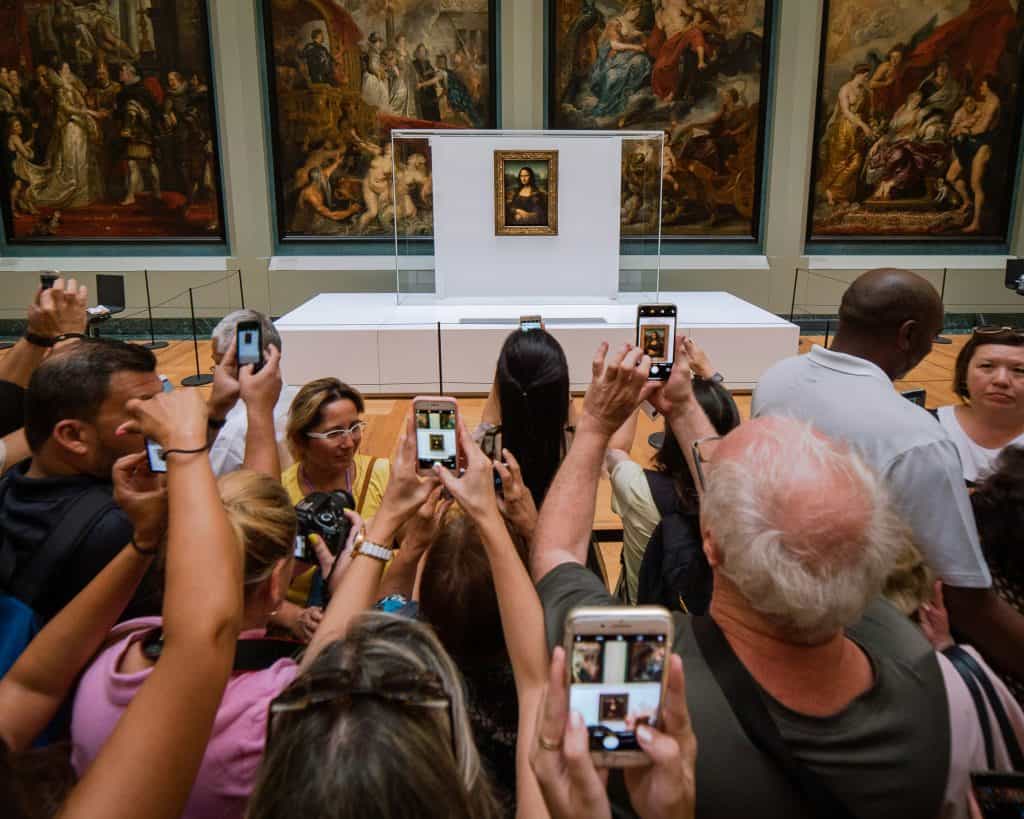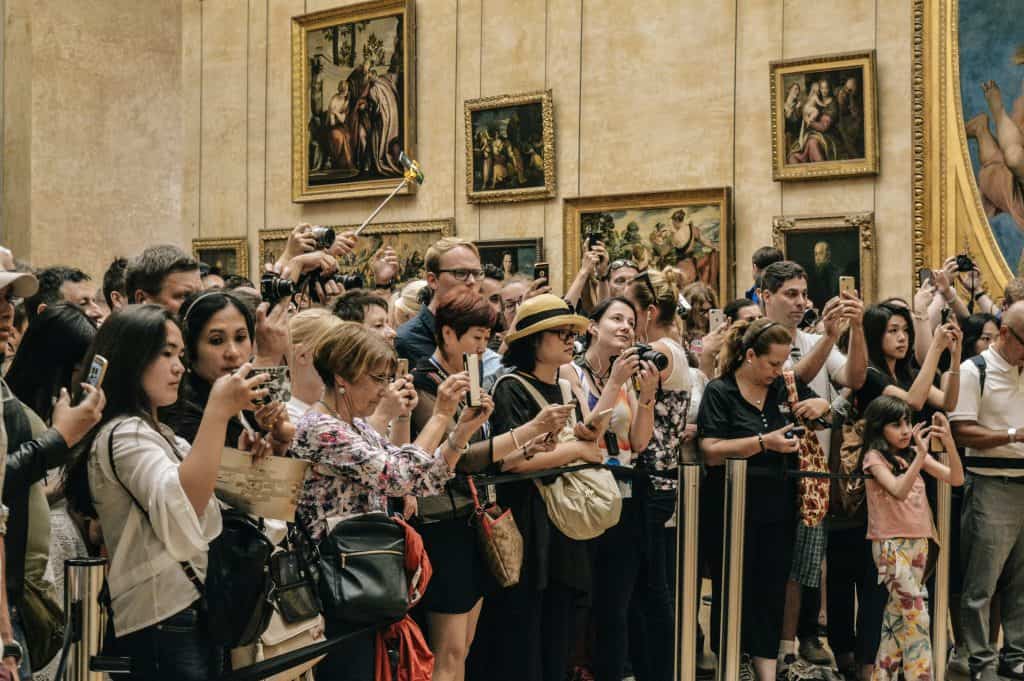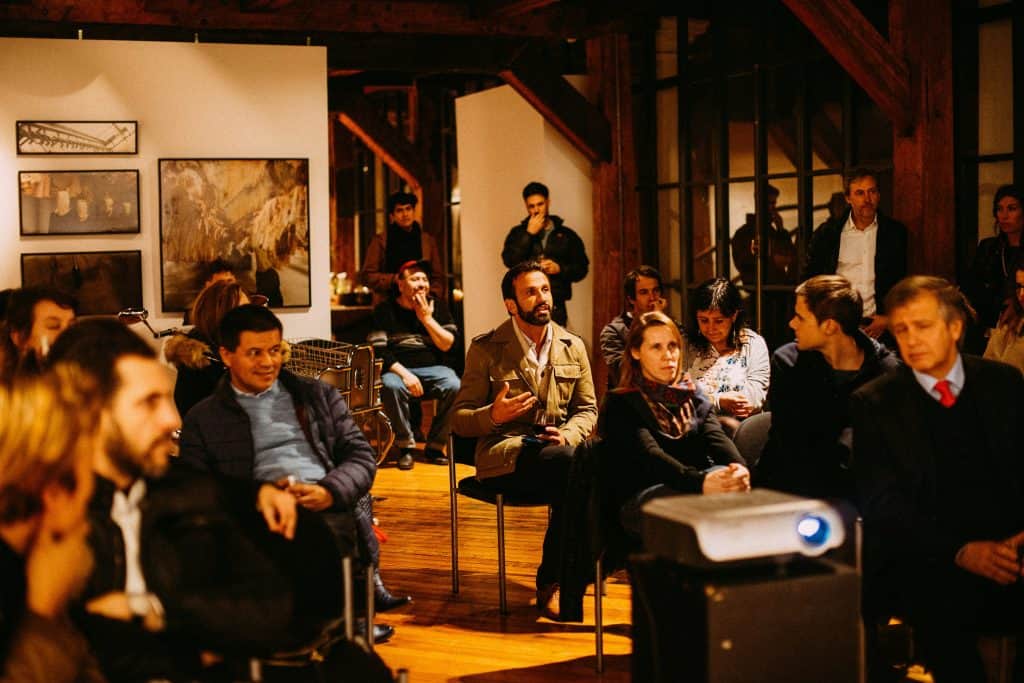
29 Mar Audience Engagement in Physical Art Exhibitions
Art exhibitions serve as spaces where audiences can immerse themselves in diverse artistic expressions, but without active audience engagement, these exhibitions risk becoming static displays. Audience engagement in art exhibitions refers to the active participation, interaction, and dialogue between viewers and the artworks on display. It involves creating experiences that resonate with diverse audiences and fosters deeper connections with the art and its context. For both audiences and institutions, robust engagement is paramount for enriching the cultural experience, promoting dialogue, and fostering appreciation for the arts.
Challenges of Audience Engagement in Physical Exhibitions

Photo by Mika Baumeister
Passivity of Traditional Exhibition Format
Traditional exhibitions have long been criticized for their passive presentation of artworks, where visitors are relegated to the role of passive observers rather than active participants in the creative process. In these settings, artworks are often displayed in static arrangements, limiting opportunities for audience interaction and exploration. Spectators may feel disconnected from the art, unable to fully engage with its meaning or context. The passivity inherent in traditional exhibition formats can create barriers to understanding and appreciation, stifling the potential for meaningful dialogue and connection between viewers and artworks. To address this issue, many contemporary artists and curators are exploring innovative approaches to exhibition design that prioritize interactivity, immersion, and audience engagement, transforming exhibition spaces into dynamic environments where visitors are invited to actively participate in the artistic experience.
Lack of Accessibility and Inclusivity
Another significant challenge facing traditional exhibitions is the lack of accessibility and inclusivity, which can lead to exclusionary experiences for visitors with diverse needs and backgrounds. Many exhibition spaces are not equipped to accommodate individuals with disabilities, whether physical, sensory, or cognitive, making it difficult for these audiences to fully participate in the art-viewing experience. Additionally, exhibitions may not adequately reflect the diversity of perspectives, cultures, and identities within the community, further alienating marginalized groups and reinforcing existing inequalities. To address these issues, cultural institutions are increasingly prioritizing accessibility and inclusivity in their programming and exhibition design, implementing measures such as wheelchair ramps, tactile exhibits, sign language interpretation, and multicultural programming to ensure that all visitors feel welcome and valued.
Difficulty in Fostering Meaningful Interaction
Creating environments conducive to genuine dialogue and reflection poses challenges in traditional exhibition settings, where visitors may feel disconnected from the artwork and each other. The formal atmosphere of many galleries and museums can inhibit spontaneous interaction and conversation, limiting opportunities for meaningful engagement and connection. Additionally, the sheer volume of artworks on display in traditional exhibitions can be overwhelming, making it difficult for visitors to focus their attention and engage deeply with individual pieces. To overcome these challenges, cultural institutions are experimenting with new approaches to exhibition design and interpretation that prioritize intimacy, interactivity, and dialogue. From guided tours and interactive installations to artist talks and community events, these initiatives seek to foster connections between visitors, artists, and artworks, creating spaces where meaningful dialogue and reflection can flourish. By embracing new models of exhibition design and interpretation, cultural institutions can create more inclusive and engaging experiences that inspire, educate, and empower audiences of all backgrounds and abilities.
Strategies for Enhancing Audience Engagement

Photo by Alicia Steels
Pre-exhibition strategies
Before the exhibition, pre-exhibition strategies play a pivotal role in ensuring its success. One significant approach involves deploying engaging marketing and outreach campaigns tailored to target specific demographics and communities. By employing targeted strategies and fostering community outreach initiatives, organizers can effectively generate interest and encourage diverse participation, enriching the exhibition experience for all involved. Additionally, providing educational resources and facilitating online engagement through virtual tours and interactive platforms serves to pique curiosity and establish connections with potential attendees before they even step foot in the exhibition space. This not only enhances anticipation but also broadens accessibility, allowing individuals from various locations to partake in the exhibition’s offerings. Furthermore, collaborative planning emerges as a cornerstone of pre-exhibition efforts, emphasizing the importance of involving diverse communities in the planning process. By incorporating diverse perspectives and voices, organizers can ensure inclusivity and relevance, thereby fostering a sense of ownership and belonging among participants and stakeholders alike. Through these multifaceted pre-exhibition strategies, organizers lay the groundwork for a dynamic and inclusive exhibition experience that resonates with audiences far and wide.
Exhibition design and layout
For visitors to have an engaging and rewarding experience, a diverse approach is necessary. Interactive components are essential because they operate as centers of interest that draw viewers in and encourage investigation. The exhibition is made alive and captivating by the addition of interactive installations and multimedia projections, which invite viewers to actively engage in the story of the artworks. Additionally, by offering background information and insights into the items on show, meaningful labeling improves visitors’ comprehension and elevates their entire experience. Immersion experiences take the exhibition to new heights by constructing surroundings that arouse the senses and immerse viewers in the world of the artwork. The purpose of the exhibition layout is to create links and meaningful interactions between the audience and the creative material via careful planning and placement.
Engagement activities and programs
Engagement activities and programs are integral to enriching visitors’ understanding and fostering connections with artwork. Guided tours and workshops led by artists, educators, or experts offer opportunities to explore themes and historical contexts. Interactive prompts throughout the exhibition encourage reflection, interpretation sharing, and dialogue among visitors, fostering creativity and personal connections with the art. The exhibition aims to create an inclusive environment for exploration, learning, and connection, inspiring curiosity and deeper appreciation through diverse engagement initiatives such as guided tours, interactive activities, and workshops.
Accessibility and inclusivity
Creating an inclusive and accessible environment within any setting involves several key considerations. Sensory adaptations play a crucial role in accommodating visitors with diverse needs by providing alternative formats and adjustments to cater to varying sensory sensitivities. These adaptations may include tactile exhibits, audio descriptions, or visual aids, ensuring that all individuals can engage meaningfully with the space. Moreover, diverse programming is essential to reflect a broad spectrum of interests, perspectives, and cultural backgrounds. By offering a range of activities and events, institutions can actively embrace inclusivity and encourage participation from a diverse audience. Central to fostering inclusivity is the establishment of an environment where every visitor feels welcomed, valued, and respected. This entails cultivating an atmosphere of openness and understanding, where differences are celebrated and barriers to access are actively addressed. Through these measures, institutions can strive to create spaces that are truly accessible and inclusive for all.
Evaluating and Measuring Success
Evaluating and measuring the success of engagement strategies within any institution requires a multifaceted approach. One key method involves tracking audience engagement data, including metrics such as attendance figures, participation rates in events and activities, and feedback gathered through surveys. By analyzing these metrics, institutions can gauge the effectiveness of their engagement strategies and identify areas for improvement. Establishing feedback mechanisms is equally essential to collect insights directly from visitors, enabling institutions to adapt their engagement strategies based on preferences and needs. This direct feedback loop allows for real-time adjustments that better align with visitor expectations, enhancing overall satisfaction. Moreover, prioritizing continuous improvement is crucial in the dynamic landscape of audience engagement. Institutions must regularly evaluate and refine their initiatives to remain responsive to emerging trends and evolving preferences. By embracing a cycle of evaluation, adaptation, and enhancement, institutions can ensure that their engagement efforts remain relevant and impactful, ultimately fostering deeper connections with their audience.

Photo by Antenna
Conclusion
Audience engagement is central to the vitality and relevance of physical art exhibitions. By prioritizing innovative strategies that promote interaction, inclusivity, and dialogue, institutions can create dynamic cultural spaces that resonate with diverse audiences. As we continue to evolve our approaches to audience engagement, we have the opportunity to shape more vibrant and meaningful art experiences for generations to come. Let us embrace the challenge and potential of engaging audiences in the rich tapestry of the art world.
Key Takeaways
- Importance of Audience Engagement: Active participation, interaction, and dialogue between viewers and artworks are essential for enriching cultural experiences, promoting dialogue, and fostering appreciation for the arts.
- Challenges in Audience Engagement: Passivity of traditional exhibition formats, lack of accessibility and inclusivity, and difficulty in fostering meaningful interaction pose challenges in engaging audiences effectively.
- Strategies for Enhancing Engagement: Pre-exhibition strategies, exhibition design and layout, engagement activities and programs, accessibility, and inclusivity are crucial components in enhancing audience engagement in physical art exhibitions.
- Evaluating and Measuring Success: Tracking audience engagement data, establishing feedback mechanisms, and prioritizing continuous improvement are essential for evaluating and measuring the success of engagement strategies in art exhibitions.
FAQs
Why is audience engagement important in art exhibitions?
Audience engagement is crucial in art exhibitions because it fosters active participation, dialogue, and deeper connections with artworks. When audiences actively engage with the pieces on display, whether through discussions, interactive elements, or immersive experiences, it enhances their understanding and appreciation of the artistic concepts and themes. Additionally, engaging exhibitions can spark curiosity and encourage visitors to explore different perspectives, contributing to a more enriching cultural experience overall.
How can institutions enhance accessibility in art exhibitions?
Institutions can enhance accessibility in art exhibitions by implementing various strategies to accommodate diverse audiences. This includes providing sensory adaptations such as audio descriptions, tactile elements, and braille labels for visually impaired visitors. Moreover, offering alternative formats such as digital guides, transcripts, and sign language interpreters can make exhibitions more inclusive for individuals with different learning styles or communication needs. Furthermore, institutions can enrich accessibility by curating diverse programming that reflects the interests and experiences of a wide range of visitors, ensuring that everyone feels welcome and represented within the exhibition space.
What role does feedback play in evaluating audience engagement?
Feedback plays a crucial role in evaluating audience engagement, as it provides valuable insights into visitor preferences, experiences, and needs. By actively soliciting feedback through surveys, comment cards, or interactive feedback stations, institutions can gather data and opinions from their audience, allowing them to assess the effectiveness of their engagement strategies. Analyzing feedback enables institutions to identify areas for improvement, understand what aspects of the exhibition resonate most with visitors, and tailor future programming to better meet audience expectations. Ultimately, feedback serves as a vital tool for institutions to continuously adapt and refine their engagement efforts, ensuring that they remain responsive to the evolving needs and interests of their audience.
“Curating a Successful Online Art Show” provides valuable tips and insights on curating art effectively to engage and captivate an online audience in a successful virtual art show.

